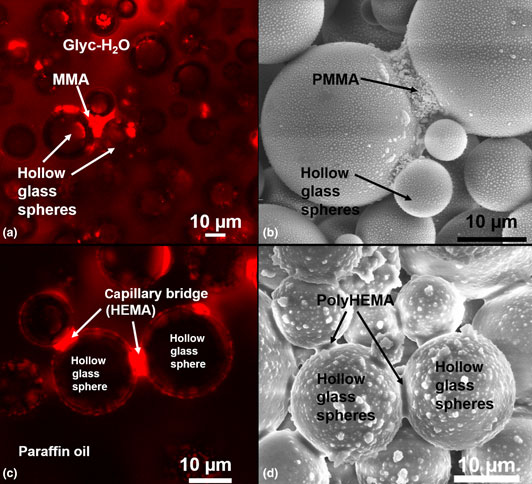Crossref Citations
This article has been cited by the following publications. This list is generated based on data provided by Crossref.
Qiao, Yunjiao
Xiang, Siying
Huang, Yajiang
Mao, Chaoying
Kong, Miqiu
Yang, Qi
and
Li, Guangxian
2019.
Microstructure of Rod-Based Capillary Suspensions with Different Rod Aspect Ratios under Quiescent and Shear Flow.
Industrial & Engineering Chemistry Research,
Vol. 58,
Issue. 22,
p.
9422.
Weiß, Moritz
Sälzler, Patrick
Willenbacher, Norbert
and
Koos, Erin
2020.
3D-Printed lightweight ceramics using capillary suspensions with incorporated nanoparticles.
Journal of the European Ceramic Society,
Vol. 40,
Issue. 8,
p.
3140.
Yang, Jeewon
Park, Hyun-su
Kim, Jieun
Mok, Jihye
Kim, Taeyeon
Shin, Eun-kyung
Kwak, Chaesu
Lim, Sehyeong
Kim, Chae Bin
Park, Jong-Sung
Na, Hyon Bin
Choi, Dalsu
and
Lee, Joohyung
2020.
Yield Stress Enhancement of a Ternary Colloidal Suspension via the Addition of Minute Amounts of Sodium Alginate to the Interparticle Capillary Bridges.
Langmuir,
Vol. 36,
Issue. 32,
p.
9424.
Behrens, Sven H.
2020.
Oil-coated bubbles in particle suspensions, capillary foams, and related opportunities in colloidal multiphase systems.
Current Opinion in Colloid & Interface Science,
Vol. 50,
Issue. ,
p.
101384.
Bindgen, Sebastian
Bossler, Frank
Allard, Jens
and
Koos, Erin
2020.
Connecting particle clustering and rheology in attractive particle networks.
Soft Matter,
Vol. 16,
Issue. 36,
p.
8380.
Tabatabaei, Maryam
Dahi Taleghani, Arash
Li, Guoqiang
and
Zhang, Tianyi
2021.
Combination of shape-memory capability and self-assembly to plug wide remote fractures.
MRS Communications,
Vol. 11,
Issue. 6,
p.
770.
Yang, Jeewon
Kim, Jieun
and
Lee, Joohyung
2022.
Effects of water-soluble polymers dissolved in an aqueous secondary fluid on the rheological properties of “capillary” suspensions.
Korea-Australia Rheology Journal,
Vol. 34,
Issue. 2,
p.
159.
Kim, Ji Hwan
Hong, Joung Sook
and
Ahn, Kyung Hyun
2022.
Secondary polymer-induced particle aggregation and its rheological, electrical, and mechanical effects on PLA-based ternary composites.
Journal of Rheology,
Vol. 66,
Issue. 2,
p.
275.
Jarray, Ahmed
Feichtinger, Annika
and
Scholten, Elke
2022.
Linking intermolecular interactions and rheological behaviour in capillary suspensions.
Journal of Colloid and Interface Science,
Vol. 627,
Issue. ,
p.
415.
Guan, Zhecun
Tang, Lisa
and
Bae, Jinhye
2023.
Rheological responses of microgel suspensions with temperature-responsive capillary networks.
Soft Matter,
Vol. 19,
Issue. 24,
p.
4432.
Chaudhary, Sagar
Velankar, Sachin S.
and
Schroeder, Charles M.
2024.
Dynamics of meniscus-bound particle clusters in extensional flow.
Journal of Rheology,
Vol. 68,
Issue. 3,
p.
397.
Chang, Joon Ha
Pin, Min Wook
Kim, Inhye
Kim, Sangbeom
Kim, Seonho
Moon, Sanghyeok
Cho, Junhee
Choi, Sieun
Heo, Boseong
Chandio, Zubair Ahmed
Kim, Youngjin
Cheong, Jun Young
Zide, Dorcas
Madondo, Mandisa
Bladergroen, Bernard Jan
Eldessouki, Mohamed
Escandell, Manuel Martinez
and
Jeon, Hee-Jae
2024.
Binder migration: Frequently observed yet overlooked phenomena in electrode processing for lithium-ion batteries.
Journal of Energy Storage,
Vol. 83,
Issue. ,
p.
110729.
Ojha, Mradul
Kumar, Lalit
and
Bhardwaj, Rajneesh
2024.
Evaporating capillary bridges of pure and binary liquids.
Physics of Fluids,
Vol. 36,
Issue. 11,
Wang, Shishuai
Fan, Zhongqin
Huang, Xinya
Gao, Yue
Sui, Hongwei
Yang, Jun
and
Li, Bin
2024.
Preparation of Chitosan Oleogel from Capillary Suspension and Its Application in Pork Meatballs.
Gels,
Vol. 10,
Issue. 12,
p.
826.
Nider, Souhaila
De Ceulaer, Femke
Göksel, Berfu
Braem, Annabel
and
Koos, Erin
2025.
Tricalcium phosphate-based capillary suspensions as inks for 3D printing of porous scaffolds.
Open Ceramics,
Vol. 21,
Issue. ,
p.
100744.
Nakanishi, Kento
Kami, Takumi
Sumita, Takehiro
Saito, Noritaka
and
Nakashima, Kunihiko
2025.
Transition Behavior of Gas Containing Suspension with Two Liquid Phase from Solid-like to Liquid-like Flows.
ISIJ International,
Vol. 65,
Issue. 6,
p.
862.
Dyab, Amro K.F.
Burska, Agata N.
and
Paunov, Vesselin N.
2025.
Aqueous two-phase emulsion systems in 3D cell culture.
Current Opinion in Colloid & Interface Science,
Vol. 78,
Issue. ,
p.
101933.
Nider, Souhaila
De Ceulaer, Femke
Göksel, Berfu
Braem, Annabel
and
Koos, Erin
2025.
Hierarchical materials with interconnected pores from capillary suspensions for bone tissue engineering.
Journal of the American Ceramic Society,
Vol. 108,
Issue. 2,



